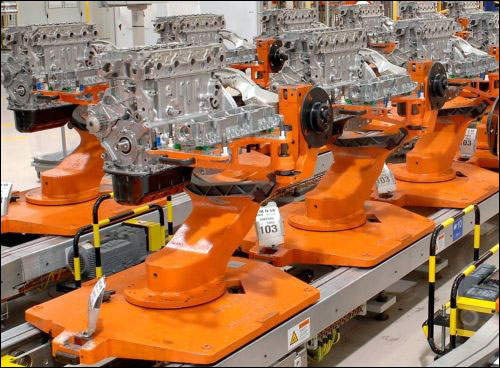Omni-id was originally a research and development team formed in the 1990s by QinetiQ, an international defense and security technology company. The team is responsible for exploring and challenging the boundaries of RFID. It has developed a breakthrough technology, passive UHF RFID tags, which can be identified with near-perfect accuracy in harsh environments, including metals and liquids. The technology has been widely used in the market.
Quanray Electronics has partnered with Omni-ID in ford motor's RFID tag project of component manufacturing to provide customized high-capacity UHF RFID chip tags that meet Ford's requirements. Ford motor became the first company to use Omni-ID's new large memory passive UHF RFID tag. At the beginning of the partnership, Ford asked Omni-ID to design a passive label with a frequency of 860-960 MHZ that would be used to trace engine components during manufacturing. Omni-id chief solution representative Ed Nabrotzky said Adept 850 was designed for Ford. Adept 850 has 64Kb memory and can encode in a range of 4 meters and read distances of up to 8.5 meters. The EPC Gen 2 RFID tag size is 65mm* 45mm*8mm, sealed in a hard IP68 class ceramic sleeve, dust-proof and watertight.

Ford already USES the tag to track car engines, and another automaker USES it to track transportation. Nabrotzky said the label had been greeted with great enthusiasm from potential customers in the automotive and energy sectors. "The typical customer comment," he says, "was -- I never imagined metal tags could have this much memory and read distance."

Due to inconsistencies in each vehicle and parts under customization requirements, tracking auto parts and vehicles during the production process is also critical. The development of this label effectively helped the automobile manufacturers build a more flexible manufacturing system.
Many automobile manufacturers have used passive HIGH-FREQUENCY 13.56MHz RFID tags to track items in the production process. It is because high-frequency tags have higher reading reliability in the metal environment and relatively large memory.
The size of memory is important in the automotive industry, where data is stored in labels rather than software on servers. It is because components often move from one factory to another. But not every company has access to the same server. As a result, Nabrotzky adds, "Omni-ID RFID tags for car parts allow the data to be stored on the tags so that car factories will continue to operate even if the network crashes."

High-frequency label has strong reliability and large memory, but short reading distance. The employee needs to carry a reader to read the label next to the production line or use a robot to read the label within the reading range. Either way, the production process is interrupted.
With more personalized order requests, the production flow is no longer linear. The assembly direction of the parts may also be different. Due to the short reading distance of HF tags, it becomes challenging to read the tags.

Adept 850 can be read and written at a distance, so readers can be placed in other parts of the factory to read and write tags. Because the tag has different UHF bands, it can also be used worldwide. In order to realize these functions, the tag adopts a cross-polarized antenna to realize the multi-frequency band. There is a line on each side of labels to meet the requirements of their respective frequencies. One side antenna can transmit 916MHz of signal, meeting the needs of North America. The other antenna can transmit a signal of 860MHz to meet the needs of Europe and Asia. Users can use the Android reader to read signals on either side of the tag or receive signals on a specific side.

In addition to having 64Kb of memory, the tag supports up to 240 bits of electronic product code (EPC). Nabrotzky, however, declined to reveal the maximum reading distance for the metal tag. Adept 850 stores a unique ID number and allows the crew to write arbitrary messages as the engine is assembled. It will enable Ford to read the label to know what type of engines is being built and prevent errors (e.g., missing a step). In the fall of 2014, the label officially went into engine production process tracking.























 点击咨询
点击咨询 021-68795432
021-68795432


 沪公网安备 31011502003477号
沪公网安备 31011502003477号